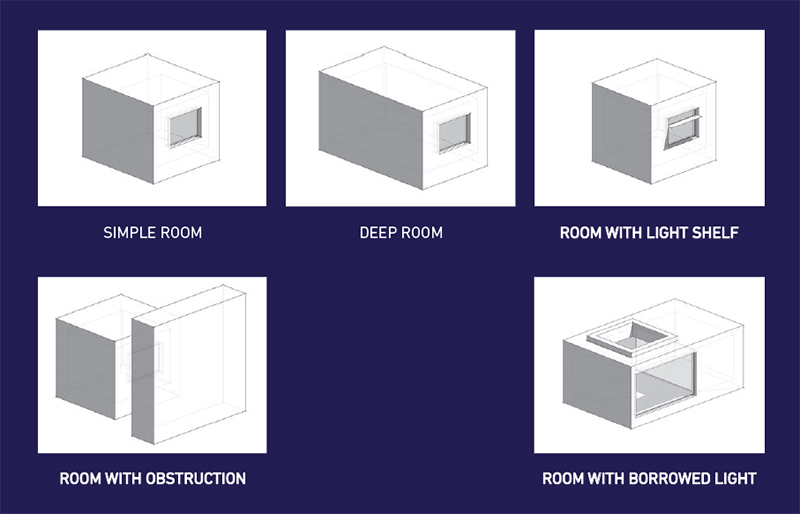

- #DAYLIGHT FACTOR CALCULATION TOOL SOFTWARE#
- #DAYLIGHT FACTOR CALCULATION TOOL PLUS#
- #DAYLIGHT FACTOR CALCULATION TOOL WINDOWS#
The building used in this analysis is a prototype office building with regularly occupied spaces having south facing (and some east facing) windows. Exterior surfaces such as overhangs, fins, etc., that obstruct and/or reflect light into the interior environment will also be accounted for.
#DAYLIGHT FACTOR CALCULATION TOOL WINDOWS#
LEED 2009 requires calculations to be done under clear sky conditions.įor interior applications, the daylight will need to be “let into” the space by creating transition openings such as windows and daylight openings in the room.
#DAYLIGHT FACTOR CALCULATION TOOL PLUS#
AGi32 uses many categories of sky to emulate these conditions: clear, partly cloudy, and overcast, plus 15 other general sky conditions described by the CIE. As the sunlight enters the atmosphere, a portion of the light is scattered by the atmospheric conditions. The daily rotation of the earth as well as its location in its orbit about the sun produces a predictable amount of sunlight at a given location. The application of daylighting in AGi32 allows you to consider the effect of sun, sky, and ground as a light source in the environment.
#DAYLIGHT FACTOR CALCULATION TOOL SOFTWARE#
Software used in this example is AGi32 by Lighting Analysts. when solar positions are “lower” in the sky, which help projects claim credit point because daylight should penetrate more deeply into the building.) (In the past, LEED required daylighting calculations to be done at noon, but now they are done at 9 a.m. Illuminance: Output of the simulation model shall show the illumination level range of 25 to 500 fc on a clear sky condition on Sept. LEED requires calculations to be done on a clear sky condition (see sidebar “Things to keep in mind” linked below). Most software brands use Illuminating Engineering Society (IES) and CIE-accepted sky models to calculate the sky’s distribution in the daylight calculations. Each sky represents a unique sky luminance distribution, which is the most effective way to classify the 15 CIE Standard Skies. Sky conditions: In 2003, the International Commission on Illumination (CIE) adopted 15 standard skies that cover a broad spectrum of the usual skies found in the world. "Non-occupied spaces are defined as spaces designed for equipment and machinery or storage with no human occupancy except for maintenance, repairs, and equipment retrieval." Examples of these include mechanical rooms, electrical rooms, storage areas, and restrooms. "Non-regularly occupied spaces are spaces that occupants pass through, or spaces used in pursuit of focused activities for less than one hour per person per day (on average)." Examples are hallways and foyers. Regularly occupied spaces: According to USGBC, "Regularly occupied spaces are areas where one or more individuals normally spend time (more than one hour per person per day on average) seated or standing as they work, study, or perform other focused activities inside a building." Some examples are private and open offices, conference rooms, break rooms, and lunch rooms. Some of the software products for daylighting analysis are AGi32, Radiance, Lumen Designer, and Daysim. The rating system does require that the simulation be done under clear sky conditions. Any software that can simulate based on the requirements listed in the rating system is acceptable. In general, the USGBC does not endorse one software brand over another. Several daylighting software analysis programs can address factors such as window area, room floor area, window geometry, window height, and the visible light transmittance of glazing and factors such as orientation, room cavity ratios, visible angle to the sky, latitude designation, and interior room reflectance resulting in development of more sophisticated design strategies that demonstrate LEED compliance.

However, software programs are increasingly used to simulate and analyze daylighting effects. View-preserving shades are not part of the study in this article.Ĭomputer software: Physical models are an accurate way to evaluate the effects of daylighting and can be a cost-effective method of analysis.Areas with illuminance levels below or above the range do not comply However, designs that incorporate view-preserving automated shades for glare control may demonstrate compliance for only the minimum 25 fc illuminance level. Demonstrate through computer simulations that 75% or more of all regularly occupied spaces achieve daylight illuminance levels of a minimum of 25 fc and a maximum of 500 fc in a clear sky condition on Sept.This article focuses on Option 1, the simulation method, defined by the USGBC as follows: The goal for any of these options is to achieve daylighting in 75% of the regularly occupied spaces. Option 4: Combination of any of the above methods. At the risk of making it sound too simple, daylighting design to achieve this credit point for LEED can be boiled down to three steps:


 0 kommentar(er)
0 kommentar(er)
